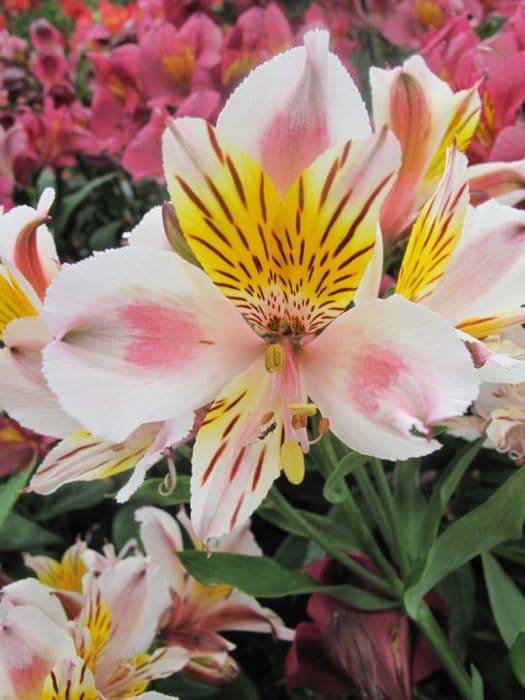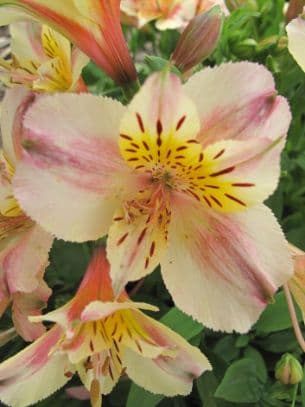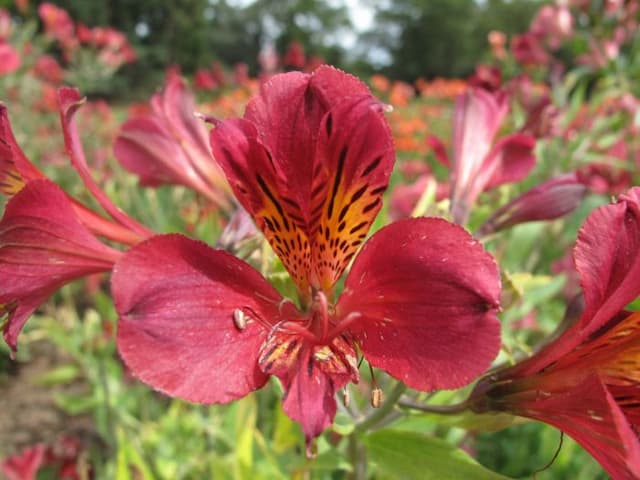Peruvian Lily Alstroemeria Princess Carmina = 'Stasilva' (Princess Series)
![Peruvian lily [Princess Carmina]](/_next/image?url=https%3A%2F%2Fplants-admin.emdemapps.com%2Fimages%2Fplants%2F%2Fimages%2F604b5b436505f.png&w=3840&q=75)
ABOUT
The Alstroemeria Princess Carmina, also known as the Peruvian Lily from the Princess Series, exhibits a vibrant display of colors that add a striking charm to any garden setting. This perennial plant brandishes a bouquet of trumpet-shaped flowers, each one intricately patterned with streaks and specks that offer a bespoke touch to the floral arrangement. The blossoms predominantly showcase a seductive blend of deep pink and burgundy hues, while golden yellow throats and flecks of chocolate brown contribute to a rich tapestry of color. The petals have a slightly ruffled edge, giving them a delicate texture that enhances the overall aesthetics of the bloom. The Princess Carmina’s foliage is equally attractive, comprised of slender, lance-shaped leaves that bear a lush green color, forming a dense clump that cradles the flowers gracefully. The leaves may be slightly glossy, adding a touch of sheen to the plant's verdant base. The Peruvian Lily's striking appearance is perfect for cutting gardens, as the flowers have a long vase life, making them ideal for indoor floral arrangements.
About this plant
 Names
NamesFamily
Alstroemeriaceae
Synonyms
Inca Lily, Peruvian Lily, Lily of the Incas
Common names
Alstroemeria 'Stasilva'
 Toxicity
ToxicityTo humans
Peruvian lily is not considered toxic to humans. Nonetheless, it's always advisable to avoid ingesting any part of ornamental plants as they are not intended for consumption and could potentially cause an upset stomach or an allergic reaction in sensitive individuals.
To pets
Peruvian lily can cause mild gastrointestinal discomfort if ingested by pets. Symptoms of poisoning may include vomiting, diarrhea, and drooling. While not severely toxic, it is still best to prevent pets from eating this plant to avoid any potential health issues.
 Characteristics
CharacteristicsLife cycle
Perennials
Foliage type
Deciduous
Color of leaves
Green
Flower color
Red
Height
1-2 feet (30-60 cm)
Spread
1-2 feet (30-60 cm)
Plant type
Bulb
Hardiness zones
7
Native area
South America
Benefits
 General Benefits
General Benefits- Long flowering period - The Alstroemeria Princess Carmina blooms for several months, providing a long-lasting display of vibrant flowers.
- Attracts pollinators - With its colorful blossoms, it draws in bees and butterflies, which are essential for the pollination of many other plants.
- Royal Horticultural Society (RHS) Award of Garden Merit - This plant has been recognized for its outstanding qualities in a garden setting.
- Drought resistance - Once established, it has a good resistance to periods of dry weather, reducing the need for frequent watering.
- Low maintenance - The plant doesn't require a lot of care, making it a good choice for gardeners of all skill levels.
- Versatility - Can be used in borders, containers, and as cut flowers, offering flexibility in garden design and indoor arrangements.
- Hardy nature - It generally withstands the rigors of various climate conditions and is resistant to many pests and diseases.
- Brightens garden spaces - Its bright and colorful blooms add aesthetic appeal to gardens, patios, or balconies.
 Medical Properties
Medical PropertiesThis plant is not used for medical purposes.
 Air-purifying Qualities
Air-purifying QualitiesThis plant is not specifically known for air purifying qualities.
 Other Uses
Other Uses- Alstroemeria Princess Carmina can serve as a striking natural dye for fabrics, giving textiles a unique and vibrant hue.
- Pressed flower art is another unusual use; the distinctive patterns and colors of the petals create exquisite designs for decorative pieces or homemade stationery.
- This plant's long-lasting flowers are perfect for creating dried flower arrangements for home decor that maintain color and shape for an extended period.
- The sturdy stems make them an interesting choice for crafting botanical jewelry, such as pendants or earrings, after drying and preserving.
- Petals of the Princess Carmina can be used in potpourri mixes, adding color and a light scent to a room when combined with other dried flowers and spices.
- The vibrant flowers can be used as a natural confetti for festive occasions, offering an eco-friendly alternative to synthetic confetti.
- Photography subjects, as their intricate details and vivid colors can produce stunning and artistic macro photography shots.
- Edible decoration for cakes and desserts, assuming they've been grown organically and free of any pesticides or harmful chemicals.
- Alstroemeria petals can also be frozen in ice cubes for an elegant and colorful touch in beverages during special events or gatherings.
- They can act as indicators for science education purposes, such as demonstrating the effects of different pH levels on plant pigments by changing the color of their petals.
Interesting Facts
 Feng Shui
Feng ShuiThe Peruvian Lily is not used in Feng Shui practice.
 Zodiac Sign Compitability
Zodiac Sign CompitabilityThe Peruvian Lily is not used in astrology practice.
 Plant Symbolism
Plant Symbolism- Friendship: Alstroemeria, also known as the Peruvian Lily or Lily of the Incas, often symbolizes strong and enduring friendship, due to its long-lasting quality as a cut flower and the mutual support between the twisted leaves.
- Devotion: The Peruvian Lily's multiple blooms per stem represent the numerous ways one can be devoted to a friend or partner.
- Wealth and Prosperity: Often given as a gift to wish someone prosperity in their life or ventures, Alstroemeria's vibrant blooms are reminiscent of a bounty of riches.
- Fortune: The unique streaks that often resemble paths in the petals suggest the convergence of multiple avenues leading to a fortunate life.
 Water
WaterPrincess lilies, including the Alstroemeria Princess Carmina, require regular watering to ensure the soil is consistently moist but not waterlogged. Water the plant thoroughly once a week with approximately half a gallon of water per plant, allowing the water to penetrate deeply into the soil. In hot, dry conditions, increase the watering frequency to twice a week, ensuring each time that excess water can drain freely to prevent root rot. During the cooler months or times of rainfall, reduce the amount of water to prevent overwatering. Be sure to check the soil moisture level before each watering to adjust the amount as needed.
 Light
LightPrincess lilies perform best in full sun to partial shade conditions. For optimal growth and flowering, place Alstroemeria Princess Carmina in a location where it receives at least 6 hours of direct sunlight each day. If grown indoors, situate the plant near a bright window that offers ample morning sunlight and diffused afternoon light to protect it from intense heat.
 Temperature
TemperatureThe ideal temperature range for growing Princess lilies is between 65 and 80 degrees Fahrenheit. They can tolerate a minimum temperature of 28 degrees Fahrenheit, but frost or prolonged exposure to cold can damage the plant. Protect Alstroemeria Princess Carmina from extreme heat by providing afternoon shade in regions where temperatures exceed the upper range of its comfort zone.
 Pruning
PruningPrune Princess lilies to remove spent flower stalks and encourage further blooming. Deadhead the Alstroemeria Princess Carmina as flowers fade by gently pulling the entire flower stem from the base; this also promotes the growth of new stems. Perform any additional pruning to shape the plant or remove any damaged or diseased tissue during the early spring before new growth begins.
 Cleaning
CleaningAs needed
 Soil
SoilThe ideal soil mix for the Peruvian Lily (Alstroemeria Princess Carmina) should be well-draining, fertile, and loamy. A mixture of two parts garden soil, one part perlite or coarse sand, and one part peat or compost would provide a suitable environment. The soil pH should be between 6.5 and 7.5 for optimal growth.
 Repotting
RepottingPeruvian Lilies should be repotted every two to three years to replenish the soil and accommodate root growth. They prefer to be slightly root-bound, so frequent repotting is not necessary. When repotting, it's critical to handle the fragile roots with care to avoid damage.
 Humidity & Misting
Humidity & MistingPeruvian Lilies thrive in moderate humidity conditions, ideally between 40-60%. They are not particularly humidity-dependent, but ensuring there is good air circulation around the plant will support its overall health and vigor.
 Suitable locations
Suitable locationsIndoor
Place in bright, indirect light and keep soil moist.
Outdoor
Choose a sunny to partial shade spot with sheltered from strong winds.
Hardiness zone
8-10 USDA
 Life cycle
Life cycleThe Alstroemeria 'Princess Carmina', commonly known as Peruvian Lily or Lily of the Incas, begins its life cycle when a seed germinates in spring, developing into a small plant with a rhizomatous root system. As it matures, the plant sends up sturdy, green stems with lance-shaped leaves, leading to its vegetative growth stage. From early summer to fall, the Peruvian Lily enters its flowering stage, producing vibrant pink to red blooms with attractive streaks and spots. After the blooming period, the plant sets seed if the flowers have been pollinated, completing its reproductive stage. In response to cooler temperatures and shorter days, the Alstroemeria 'Princess Carmina' enters a period of dormancy during winter, with above-ground growth dying back. With the return of warm weather in spring, the cycle starts anew as the plant breaks dormancy and resumes growth, using stored energy in its underground tubers to fuel the next season's growth and reproduction.
 Propogation
PropogationPropogation time
Spring-Early Summer
Alstroemeria, commonly known as the Peruvian Lily or Lily of the Incas, can be propagated through division, which is the most popular method. The best time to divide Alstroemeria is in the late winter or early spring before new growth begins. To propagate by division, gently lift the clump of tubers from the ground using a garden fork, ensuring minimal damage to the tubers. Once the clump is out, tease apart the individual tubers, each with a section of root and shoots attached, using your hands or a sharp knife if necessary. Replant the divisions immediately at the same depth they were previously growing, spacing them about 12 inches (approximately 30 centimeters) apart, and water them in well to help establish the new plants. This method not only creates new plants but also maintains the vigor of the existing ones by preventing overcrowding.




![Peruvian lily [Inca Glow]](/_next/image?url=https%3A%2F%2Fplants-admin.emdemapps.com%2Fimages%2Fplants%2F%2Fimages%2F604b5e99e48d9.png&w=640&q=75)
![Peruvian lily [Inca Smile]](/_next/image?url=https%3A%2F%2Fplants-admin.emdemapps.com%2Fimages%2Fplants%2F%2Fimages%2F604b5cad8fa91.png&w=640&q=75)
![Peruvian lily [Inticancha Passion]](/_next/image?url=https%3A%2F%2Fplants-admin.emdemapps.com%2Fimages%2Fplants%2F%2Fimages%2F604b5f7a78c8d.png&w=640&q=75)


